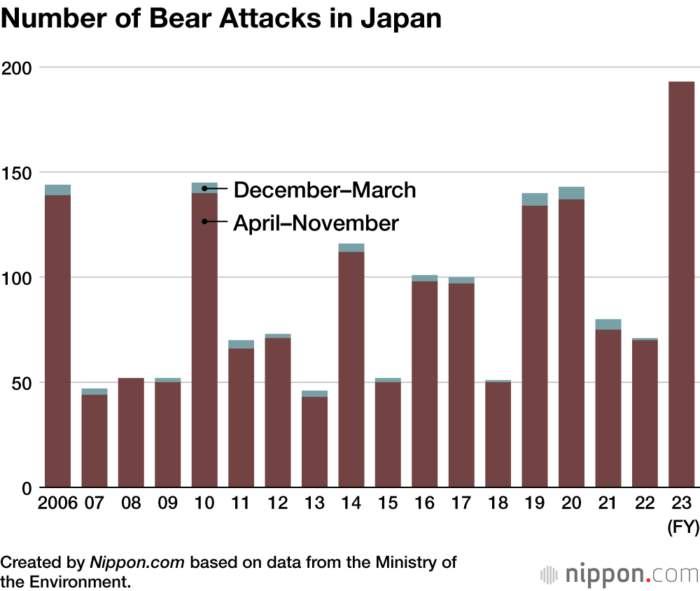A record number of bear attacks across Japan have caused widespread alarm and six fatalities in the last year, prompting repeated warnings from authorities and wildlife experts.
Of the 219 attacks in the last 365 days, one of the most publicized occurred when a brown bear allegedly decapitated a Hokkaido fisherman.
Decapitated head found during search for fisherman believed to have been attacked by bear https://t.co/4KZ5vtI9vq pic.twitter.com/WzGYhvVaKx
— The Messenger (@TheMessenger) May 17, 2023
Brown and black bears are under stress from depleted food sources and expanding human populations. In Japan, bears emerge from hibernation around this time of year, hungry and looking to forage. Authorities have already cataloged 32 sightings across the country since April 1, the South China Morning Post reported — 50% more than average.
Bad mood bears
Kevin Short, a naturalist and former professor of cultural anthropology at Tokyo University of Information Sciences, says it’s common for bears to wake up “in a bad mood” after winter. But diminished foraging conditions are pushing them to the brink.
“Last autumn saw an almost total failure of the nut harvest, especially of beech nuts, and that is what the bears rely on to fatten themselves up just before they go into hibernation,” he explained. “The crop was the worst that I can remember, and a lot of bears went into hibernation without sufficient energy reserves to get them through the winter.”
A warm, short winter has also contributed to the situation, which has worsened steeply in recent years. A 2023 official report shared by the Nippon Times showed that sightings hovered near record levels in 2019 and 2020. Attacks, on the other hand, skyrocketed in 2023. No more than 150 occurred in any previous year since 2006.

“More and more, rural farmlands in the foothills that once acted as buffer zones between the bears and humans are disappearing,” Shinsuke Koike, a specialist in biodiversity, forest ecosystem, and bears at the Tokyo University of Agriculture and Technology, told the BBC. “What we need to think about doing now is how to get the bears back into the mountains.”
Hunting ban lifted
Prefectural governments have taken measures both violent and nonviolent toward that end. Japan’s public broadcaster, NHK, shared a series of 30-second instructional videos last year on what to do during bear encounters. And Hokkaido legalized bear hunting again after a decades-long ban.
The 1990 ban protected bears while their numbers guttered at around 5,000. But now, according to reports, populations in the prefecture have doubled. Over 12,000 bears roamed Hokkaido by 2021. Of those, the government caught and killed over 1,000.
Elsewhere, farmers and village-dwellers use robotic “monster wolves” and live dogs to keep bears at bay.

So-called ‘Monster Wolves’ allegedly keep wildlife at a distance.
Still, encounters will likely increase as Japan’s rural population continues to decline. And uninformed tourists can face especially high risks in areas like Hokkaido.
As always, experts urge backcountry visitors to be prepared and safety-educated where bears are present.






